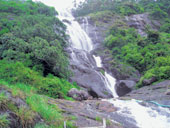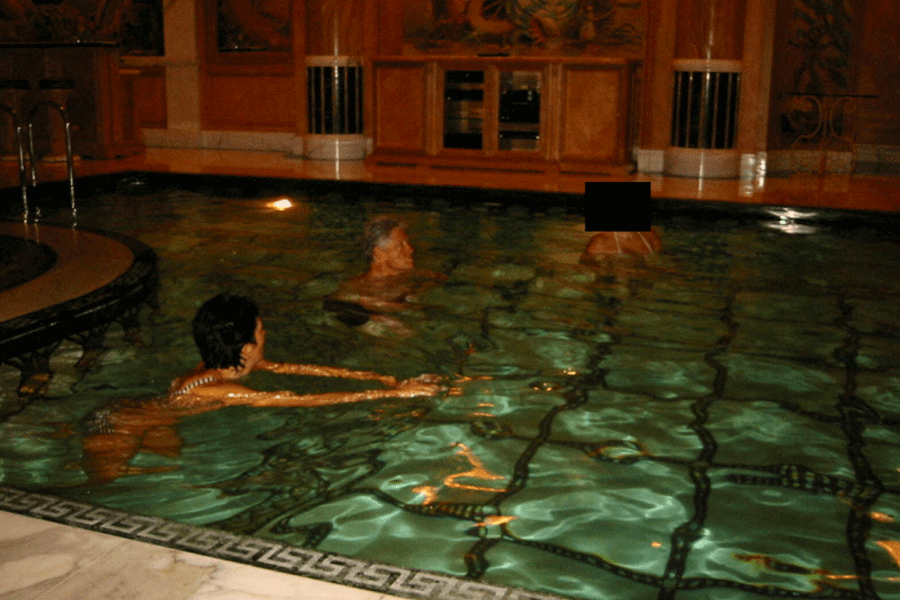 |
 |
 |
 |
| (From top): One of the many waterfalls that abound in Munnar; manicured acres of a tea plantation; cardamom growing in the wild; flora and fauna make for a glorious view from the High Range Club |
I expected to see a lot more natural beauty here!” I exclaimed with some disappointment when I reached Munnar. As first impressions of this verdant tea-growing town in the Anamallais go, this wasn’t quite what the hotel manager expected to hear. “Madam, there’s natural beauty all around us! Look out of the window and gaze at the mist gathering below the lovely rolling hills covered in tea bushes. I’ve been here so long and the sight still moves me!” said he.
I looked out of the window dutifully. Acre upon manicured acre of tea plantations stretched out as far as the eye could see. Each bush was shaped perfectly round just so, exactly a couple of yards away from its neighbours. Neat rows of silver oaks, trimmed so that they didn’t deprive the tea bushes of sunshine, stood like soldiers on attention between the bushes. Puffy clouds floated dreamily in the valley below, looking as if they’d been placed there for best effect. It was so green it almost hurt the eyes ? pretty it was, but natural it certainly wasn’t.
The view, I must admit, grew on me in the next few days that I spent traversing the length and breadth of Munnar.
Every inch of the hills, it seemed, was covered in tea estates, tea estates and then some more tea estates. All in all, tea bushes cover 24,000 hectares of prime land in these parts. For Munnar’s misty high ranges are ideally suited for tea cultivation, being second only to Cherrapunji in the amount of rainfall they receive.
The only respite from the unchanging view came when the mist lifted once in a while, revealing wild, craggy peaks (including Anaimudi, the peninsula’s highest point), providing a nicely wild backdrop to the manicured perfection below.
The best way to spend one’s time in Munnar, we found, was to walk around and breathe the clean, fragrant air. Weather permitting, of course. For when the weather here is good, it’s very very good ? and when it’s bad, it rains. The monsoon reached Kerala just when we did, and so it rained everyday while we were in the little tea town.
Come to think of it, rain is too mild a word for what we experienced in Munnar ? there were gale force winds accompanied by sheets of rain so powerful that I thought they’d probably bore holes in our pathetic city-bred umbrellas. It turned the gurgling mountain streams muddy brown, and the roads, slick and dangerous. It also made it impossible to step out for dinner on Munnar’s circuitous, dark roads.
But when it didn’t rain, the days were cool and pleasant. In Tamil, the word ‘Munnar’ means three rivers ? appropriate as it is situated at the confluence of three mountain streams. Waterfalls and rivulets abound, and we found plenty of good spots to splash and picnic in. The area we were staying in, Chinnakanal was surrounded by tea and spice plantations, affording many interesting walks.
During a leisurely ramble, we found some cardamom plants growing wild ? they looked as if they’d escaped from a large cardamom plantation uphill. Long sword-like leaves, fragrant when crushed, hid the stalk growing from the bottom of the plant where the cardamom pods grew.
Spice planters, we were told, rub these pods on a wire mesh and polish them before sending them for grading and packing. Besides cardamom, we learnt, pepper, cinnamon, cloves and nutmeg are also grown in Munnar. Unfortunately, we were so botanically challenged, we probably walked past forests of cinnamon trees and sneezed under pepper vines, without recognising them.
That’s why it took the town’s sleepy market to educate us about this area’s rich bio-diversity. The little shops were brimming with local produce ? tea, spices, cashew nuts, fresh vanilla pods, coffee beans, dried garlic and ginger and essential oils. And mercifully, everything was labelled. Cashews, believed to have been introduced to Kerala by Portuguese traders, were being sold everywhere. Fried, roasted or plain they were dirt cheap and delicious.
For tea, of course, we went to the Tata Tea Depot, which sold everything from orthodox tea leaves to exotic flavoured green teas and essential oils. “What is tea tree oil used for?” I asked the saleslady. She told me that just a drop in a spoon of coconut oil was a safe and sure remedy for acne. I bought it, as well as a bottle of lemon grass oil, useful for its mosquito repelling properties as well aromatic flavour. Jars of fresh strawberry jam also went into our shopping bags before one could say ‘excess baggage’.
Later, I learnt that much of the essential oil in these parts, especially lemon grass oil, is distilled by forest-dwelling tribes living on the Annamalai Hills, whose natural habitat became a protected area about four decades ago. The Muduvans, for example, used to practice shifting agriculture, hunting and gathering in the forests of Munnar.
Today, tea and cardamom cultivation, apart from essential oil production, brings home their bacon. These aborigines of the High Ranges were experts in jungle craft and in surviving this tough jungle terrain. So when the British came to Munnar and saw the commercial possibilities of tea cultivation, they turned to them for labour. But tea estates were one of the biggest causes of the decimation of the rich forest cover of these hills. So inevitably, when the remaining forests were declared protected, the Muduvans shifted to shanties on the outskirts of tea estates and the reserved forests around Munnar, barely eking out a living.
Not far from Munnar, the beauteous Eravikulam National Park is one such protected area. Its dense forests and rolling grasslands are home to the endangered Nilgiri tahr (Nilgiri Ibex). These animals had almost become extinct when the forests around Munnar were declared a National Park in 1978. Today, thanks to a concerted conservation effort, there are over a thousand tahrs here. Sadly, it’s the tribals who’ve traditionally lived in, and off these forests who are the endangered species today.
But then, that’s Munnar for you. The Scots and Brits who came here a century ago, turned it into a small facsimile of their own homeland. Today, visitors to Munnar rave about the beautiful, snobbish High Range Club, where the old boys congregate in the men’s only bar after a round of golf. The invisible hands that keep the tea estates so immaculate, stay that way. But then, I mused, walking through the masses of flowers at the High Range Club, who said life was fair? After all, everyone admires a beautiful woman ? not the make-up artiste who made her look that way!
Photographs by the author











